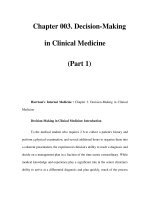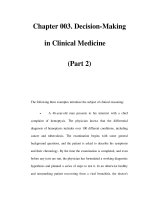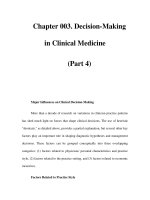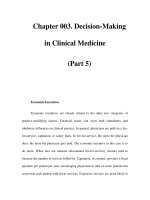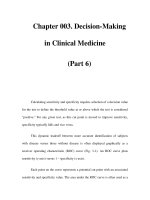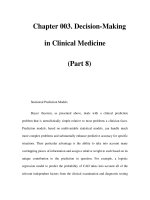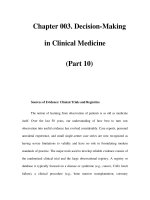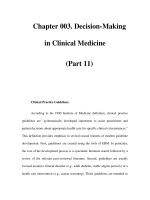Chapter 065. Gene Therapy in Clinical Medicine (Part 3) docx
Bạn đang xem bản rút gọn của tài liệu. Xem và tải ngay bản đầy đủ của tài liệu tại đây (47.57 KB, 6 trang )
Chapter 065. Gene Therapy in
Clinical Medicine
(Part 3)
Long-Term Expression in Genetic Disease: In Vivo Gene Transfer with
Recombinant Adeno-Associated Viral (AAV) Vectors
Recombinant AAV vectors have emerged as attractive gene delivery
vehicles for genetic disease. Engineered from a small replication-defective DNA
virus, they are devoid of viral coding sequences and trigger very little immune
response in experimental animals. They are capable of transducing nondividing
target cells, and the donated DNA is stabilized primarily in an episomal form, thus
minimizing risks associated with insertional mutagenesis. Because the vector has a
tropism for certain long-lived cell types, such as skeletal muscle, the central
nervous system (CNS), and hepatocytes, long-term expression can be achieved
even in the absence of integration.
Clinical trials using recombinant AAV vectors are now ongoing for
muscular dystrophies, α
1
-antitrypsin deficiency, lipoprotein lipase deficiency,
hemophilia B, and a form of congenital blindness called Leber's congenital
amaurosis. Hemophilia is often considered a promising disease model for gene
transfer, as the gene product does not require precise regulation of expression and
biologically active clotting factors can be synthesized in a variety of tissue types,
permitting latitude in choice of target tissue. Moreover, raising circulating factor
levels from <1% (levels seen in those severely affected) into the range of 5%
greatly improves the phenotype of the disease. Preclinical studies with
recombinant AAV vectors infused into skeletal muscle or liver have resulted in
long-term (>5 years) expression of factor VIII or factor IX in the hemophilic dog
model. Administration to skeletal muscle of an AAV vector expressing factor IX
in patients with hemophilia was safe and resulted in long-term expression as
measured by muscle biopsy, but circulating levels never rose >1% for sustained
periods, and a large number of IM injections (>80–100) was required to access a
large muscle mass. Intravascular vector delivery has been employed to access
large areas of skeletal muscle in animal models of hemophilia and will likely be
tested in upcoming trials. Administration of an AAV vector expressing factor IX
to the liver in humans with hemophilia resulted in therapeutic circulating levels at
the highest dose tested, but expression at these levels (>5%) lasted for only 6–10
weeks before declining to baseline (<1%). A memory T cell response to viral
capsid, present in humans but not in other animal species (which are not natural
hosts for the virus), may be a contributing factor in the loss of expression.
Fortunately, triggering of the memory T cell response appears tissue-specific, and
it is possible that introduction of the vector into immunoprivileged sites, such as
the CNS (e.g., for Parkinson's disease) or the retina, will avoid this complication.
Leber's congenital amaurosis (LCA) is a form of retinal degenerative
disease, characterized by severe early-onset blindness. This disease, not currently
treatable, is caused by mutations in several different genes; ~15% of cases of LCA
are due to a mutation in a gene, RPE65, encoding a retinal pigment epithelial
protein. In dogs with a null mutation in RPE65, sight has been restored after
subretinal injection of an AAV vector expressing RPE65. Transgene expression
appears to be stable, with the first animals treated >5 years ago continuing to
manifest electrophysiologic and behavioral evidence of visual function. As is the
case for X-linked SCID, gene transfer must occur relatively early in life to achieve
correction of the genetic disease, although the exact limitations imposed by age
await clinical studies. AAV-RPE65 trials have now been approved in both the
United States and Great Britain. Other inherited retinal degenerative disorders may
also be amenable to correction by gene transfer, as are certain complex acquired
disorders such as age-related macular degeneration, which affects several million
people worldwide. The neovascularization that occurs in age-related macular
degeneration can be inhibited by expression of vascular endothelial growth factor
(VEGF) inhibitors such as angiostatin, or through the use of RNAi-mediated
knockdown of VEGF. Early-phase trials of siRNAs that target VEGF RNA are
underway, but these require repeated intravitreal injection of the siRNAs; an AAV
vector–mediated approach might allow long-term knockdown of VEGF.
Gene Therapy for Cancer
The majority of clinical gene transfer experience has been in subjects with
cancer (Fig. 65-1). As a general rule, a feature that distinguishes gene therapies
from conventional cancer therapeutics is that the former are less toxic, in some
cases because they are delivered locally (e.g., intratumoral injections), and in other
cases because they are targeted specifically to elements of the tumor
(immunotherapies, anti-angiogenic approaches).
Cancer gene therapies can be divided into local and systemic approaches
(Table 65-2). Some of the earliest cancer gene therapy trials focused on local
delivery of a prodrug or a suicide gene that would increase sensitivity of tumor
cells to cytotoxic drugs. A frequently used strategy has been intratumoral injection
of an adenoviral vector expressing the thymidine kinase (TK) gene. Cells that take
up and express the TK gene can be killed after the administration of gancyclovir,
which is phosphorylated to a toxic nucleoside by TK. Because cell division is
required for the toxic nucleoside to affect cell viability, this strategy was initially
used in aggressive brain tumors (glioblastoma multiforme) where the cycling
tumor cells were affected but the nondividing normal neurons were not. More
recently, this approach has been explored for locally recurrent prostate, breast, and
colon tumors, among others.
Table 65-2 Gene Therapy Strategies in Cancer
Local/regional approaches
Suicide gene/prodrug
Suppressor oncogene
Oncolytic virus
Systemic response
Chemoprotection
Immunomodulation
Anti-angiogenesis
